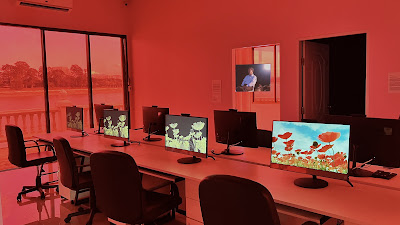矽晶小夜曲 Silicon Serenade
虛擬實境、電腦主機裝置、浮球裝置、拼接螢幕Virtual reality, host computer installation, buoyant ball installation, spliced screens. 450 x 100 cm. 5 min. 2024
The beach is covered with silicon, an essential component of the semiconductor chips used in various digital technology products. Through a series of processes, circuits are etched onto wafers and then cut into many fingernail-sized chips. These powerful chips are what make artificial intelligence possible. This work traces the origin of the materiality behind these AI chips through their manufacturing process, presented through a kind of digital texture.
沙灘上佈滿矽,它是運用在各種數位科技產品中的半導體晶片的重要組成元素。透過一系列的製程,電路被蝕刻到晶圓上,再被切割成許多指甲大小的晶片。這些功能強大的晶片使人工智慧成為可能。這件作品透過AI晶片背後的製程,回溯源起的物質性,呈現數位的觸感。
此作品以遊戲引擎搭建了一個虛擬沙灘的場景,隨著海浪的波動,海面上的數個虛擬電子螢幕播放著實拍影片,這些影像包括了水面下表演者的大提琴演奏,以及藝術家在新竹工研院所拍攝的實驗室,這是AI技術關鍵的CoWoS晶片製程。作品的音樂採用了電子曲風,是由AI自動生成,透過沙灘、矽、晶圓、AI這段製程當中所提取的關鍵字,生成歌詞、旋律和演奏,並由AI演唱。這段AI所生成的音樂交織著大提琴樂音、實驗室畫面與虛擬沙灘。
展覽裝置是由VR頭顯裝置、懸掛在空間中的浮球與電子螢幕所構成,浮球在空間中緩緩地晃動,這個運動軌跡連動了VR頭顯裝置當中的影像,這是由浮球動態所產生的運鏡,並投放在電子螢幕上,呈現了浮球的第一人稱視角,以及這段物質到數位的旅程。
The beach is covered with silicon, an essential component of the semiconductor chips used in various digital technology products. Through a series of processes, circuits are etched onto wafers and then cut into many fingernail-sized chips. These powerful chips are what make artificial intelligence possible. This work traces the origin of the materiality behind these AI chips through their manufacturing process, presented through a kind of digital texture.
This work uses a game engine to create a virtual beach scene. As the waves fluctuate, several virtual screens on the sea surface play live videos. These videos include cello performances by underwater performers and footage of a laboratory at the Hsinchu Industrial Technology Research Institute, showcasing the CoWoS chip manufacturing process which is so crucial for AI technology. The music in the work adopts an electronic style and was actually generated by AI. Using keywords extracted from the process involving the beach, silicon, wafers, and AI, the AI generated the lyrics, melody, and performance, and even sang the song. This AI-generated music is intertwined with the cello music, laboratory footage, and virtual beach.
The exhibition’s installation consists of a VR headset, a floating sphere suspended in space, and an electronic screen. The floating sphere gently sways in the space, and the trajectory of its movement is directly linked to the images in the VR headset. This motion, generated by the dynamics of the floating sphere, is projected onto the electronic screen, presenting a first-person perspective of the sphere and its journey from physical to digital.








